|
 ©
By Dolane Larson ©
By Dolane Larson |
As Néstor
Ferioli pointed out in his seminal work1 , La Fundación Eva Perón has two parallel histories, one
official and one unofficial. The official trajectory of the Fundación
can be found in legal documents, archives, newspapers and books. The unofficial
history of the Fundación has entered into the realm of folklore,
both Peronista and antiPeronista.
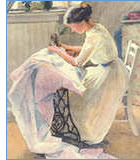 The
deepest roots of the Fundación can be found in Evita’s childhood
when she learned from her mother to reach out to those in need. Evita
was a mirror image of Doña Juana, a widow who sewed day and night
to support her five children, yet never turned down their requests for
a few coins or a hot tea to help those for whom no safety net existed. The
deepest roots of the Fundación can be found in Evita’s childhood
when she learned from her mother to reach out to those in need. Evita
was a mirror image of Doña Juana, a widow who sewed day and night
to support her five children, yet never turned down their requests for
a few coins or a hot tea to help those for whom no safety net existed.
In the small pampas towns of Los Toldos and Junín where she grew
up, Evita met the homeless (El Señor “Buendía”
who lived in the hedgerows but always greeted her with a cheerful “Buendía,
mi hija”), the mentally ill (la Mujer del Niño Muerto who
year after year asked for money to bury her dead child), and people with
disabilities (Doña Asunción who applauded from her wheelchair
Evita’s acrobatic attempts to make her laugh)2 .
She was to continue to meet their counterparts throughout her life and
especially after Perón’s inauguration as President on June
4, 1946.
From the very beginning in the Secretaría de Trabajo y Previsión
where he had worked as Secretary of Labor from 1943-1945, Perón
had established a direct personal relationship with those who recurred
to him: Perón-People. He personally met with not only union leaders
but with any individual worker who asked him for an audience.
 After
Perón’s inauguration as President, the workers lost and missed
their direct contact, their personal relationship with him. Although he
could no longer attend to them himself, the workers and the poor knew
where he lived and began to ring the doorbell of the Presidential Residence
in Buenos Aires3.
Evita had already decided that she would not be a traditional First Lady
(a title that Jacqueline Kennedy said sounded like the name of a horse);
she began to find ways to meet the needs of the people who crowded the
sidewalks outside her house. After
Perón’s inauguration as President, the workers lost and missed
their direct contact, their personal relationship with him. Although he
could no longer attend to them himself, the workers and the poor knew
where he lived and began to ring the doorbell of the Presidential Residence
in Buenos Aires3.
Evita had already decided that she would not be a traditional First Lady
(a title that Jacqueline Kennedy said sounded like the name of a horse);
she began to find ways to meet the needs of the people who crowded the
sidewalks outside her house.
By September the mail averaged 3,000 letters a day and long lines of mothers
with babies in their arms and toddlers clutching at their skirts, of older
people and people with disabilities, the forgotten and forsaken of society,
daily converged on the Residence. Evita knew she had to find a way to
offer them immediate help. She began to buy food and clothing with her
own money and stack the boxes and bundles in an unused garage on the Residence
property. When the labor unions found out, they began to send contributions
- everything from shoes to sugar.
After Perón went to bed at night, Evita, her private secretary,
Atilio Renzi, her maid, Irma Ferrari, the cook, Bartolo, and two waiters,
Sánchez and Fernández, would work until dawn to package
the merchandise. One day Perón visited the garage, and was surprised
to find that all the items were brand new.
“Of course,” Evita replied. “I’m buying some things
with my own money and some are donated by people who want to help.”
“Well, this is a real delight for the needy! “(“Es una
verdadera delicia para los necesitados!”) exclaimed Perón,
and from then on the garage was known as “La Tienda de las Delicias”
or “The Store of Delights.”
In his book, Del Poder al Exilio,4 Perón reminisced about the official beginning of the Fundación
Eva Peron:
“One night at the dinner table, [Evita] explained her program. She
sounded like a calculator.
I asked her, ‘And the money?’
She looked at me in amusement. ‘That’s easy,” she replied.
“I’ll start with yours.’
‘With mine? What money of mine?’
‘Your salary as President.’ ”
 On
a spring day in September of 1946, when the scent of the jacaranda filled
the air around Plaza de Mayo, Evita began to meet people in the same office
Perón had once occupied as Labor Secretary5.
Hoping to fill the vacuum his absence had created, she kept to the same
open door policy; both workers and “descamisados” knew where
to find her when they needed her. On
a spring day in September of 1946, when the scent of the jacaranda filled
the air around Plaza de Mayo, Evita began to meet people in the same office
Perón had once occupied as Labor Secretary5.
Hoping to fill the vacuum his absence had created, she kept to the same
open door policy; both workers and “descamisados” knew where
to find her when they needed her.
Even though Evita never took “time off” to sit down and formally
design an organization that would meet the many and varied needs of the
people who came to her with their problems, she did realize that soon
she would require more hands and minds, more structure and more space
than were readily available. The people who looked to her with faces full
of trust had long lived with no safety net for health care or housing;
the price to be paid for years of neglect would be high; the personal
price higher than she could ever have imagined at the time.
In 1947, Evita went to Europe with the idea that Europe would teach her
how to meet the needs of the most destitute of her country. What she discovered
in the war-ravaged Old World disillusioned her. Most of the institutions
she visited had been created by the state or by the wealthy... “and
the rich, when they think of the poor, think poorly.”6 Evita came back from Europe with the goal of thinking richly, of creating
works that the rich would design for themselves, would consider good enough
for their children to live in, learn in, play in, and be sick in. And
she succeeded.
On June 19, 1948, degree number 220.564 established the María Eva
Duarte Social Help Foundation ( In 1950, this name was simplified into
the Fundación Eva Perón, the Eva Perón Foundation,
just as the bouffant hairstyles and big hats of the ‘40’s streamlined
into the elegant chignons and tailored suits of the ‘50’s).
The Foundation had five goals, summarized here:
 1.
To loan money, provide tools, establish scholarships for deserving people
who lack resources. 1.
To loan money, provide tools, establish scholarships for deserving people
who lack resources.
2. Construct housing for needy families.
3. Construct educational establishments, hospitals, recreational facilities
and / or any other edifice which the Foundation considers necessary.
4. Construct buildings for the common good which can be transferred with
or without charge to National, Provincial or Municipal governments.
5. Contribute or collaborate by any means available to the realization
of works constructed for the common good and which help meet the basic
needs of the least favored social classes.
Even though she had teased him about it, Evita did not make use of Perón’s
salary; she used $10,000 pesos of her own money as the Foundation’s
first patrimony.
Nestor Ferioli points out that
“Evita constructed the Foundation rapidly, in the same way that she
would later organize the Peronista Women’s Party [el Partido Peronista
Feminino]. She thought it best so as to be able to work quickly to have
a verticalist, pyramid structure which gave her absolute freedom to make
decisions and enabled her to escape from the bureaucracy she so detested.
That is why people say that Evita wouldn’t tolerate “second
fiddles” around her. That is also why the Foundation did not have
any irrelevant rules or administrators until 1953 [after Evita’s
death].” 7
From its beginnings in an unused garage to its destruction in 1955 at
the hands of those who, when they think of the poor, think poorly, the
Foundation played an almost magical part in Argentine history; it was
an anchor, a harbor, a door which opened when all other doors had been
slammed shut. Many people in Argentina today wish they could find the
key to open that door and be comforted by the face on the other side of
it.
Nestor
Ferioli, La Fundación Eva Peron/ 1, Centro
Editor de America Latina, 1990.
Erminda Duarte, Mi Hermana Evita, Centro de Estudios Eva Peron,
1973.
The President of Argentina works in Government House, the Pink House “la
Casa Rosada”.Perón and Evita lived in the Presidential Residence,
the “Palacio Unzue”. Because Perón and Evita had lived
there, and Evita had died there, the mansion was razed by the military
after the 1955 Coup d’Etat which overthrew Perón. At present,
the National Library occupies the site.
Juan Perón: Del Poder al Exilio , p.72.
This beautiful building graced with a clocktower is now the Consejo de
Deliberante.
Eva Peron, La Razon de Mi Vida, p. 180
Ferioli, op.cit., p. 36 |
 |

Mundo
Peronista, July 1, 1954
Translated
by Dolane Larson © |
Just a few days ago-last June 19th -the New Argentina celebrated the
sixth anniversary of the "creation" of the Eva Perón Foundation.
Strictly speaking, what we have commemorated has simply
been the... date in which the institution...was legally constituted as
a Foundation.
Evita’s work
did not begin on June 19, 1948, but rather during the second half of the
year 1946; ... it actually began
to show tangible results just after General Perón was inaugurated as President
on June 4, 1946.
How did Evita’s
work of love begin?
Evita herself explained
in chapter 29 of La Razón de mi Vida when she refers to the beginnings:
"But before just
wages and worthy working conditions could give their fruits of comfort,
it was necessary to remedy the grief of so many years.
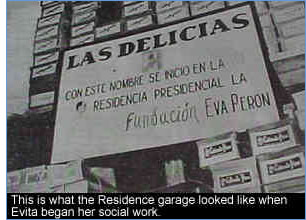 "Everywhere
homes, clothes, health were lacking. "Everywhere
homes, clothes, health were lacking.
"That is why
I had gone out into the streets to say:
‘Here
I am. I want to be of some use to my people.’
"When I noticed that my country’s descamisados
had listened to my then timid voice; when I began to see that letters
arrived, and more letters, and men and women, youths and children and
the elderly began to knock on the doors of our private residence, only
then did I realize what the "appeal from my heart" would signify.
"Although I had already foreseen that it was an almost impossible
undertaking, I was convinced of it when the full meaning of the task became
apparent to me.
"Yet Perón had
already taught me many things, and among them was to delete the word impossible
from my dictionary.
"He, who flew
"high and alone like the condors" (I use the words he is wont
to apply to the men of genius he admires: San Martín, Alexander, Napoleon),
had taken me out of the "flock of sparrows" and had given me
my first lessons.
"One, the first
perhaps, was to make me forget the word impossible.
"And we began. Bit by bit. I could not say exactly
on what day. What I do know is that at first I attended to everything
myself. Then I had to ask for help. And finally I was obliged to organize
the work, which in a few weeks had become extraordinary.
"It is true that
from the first day I relied on the moral and material help of the President,
but it was never a case of leaning too much on him who had other and much
more serious problems than mine.
"I remember at one time we were wondering whether
it was expedient that I undertake the task, or whether perhaps it should
be handled by some State organization.
"And it was Perón
himself who told me:
‘Peoples
much smitten by injustice have more confidence in persons than in institutions.
‘In this, more that all the rest,
I am frightened of the bureaucracy.
‘In the government it is necessary
to have much patience, and to know how to wait for everything to get going.
‘But
in works of social welfare it is not possible to wait for anyone.’
"This reasoning, logical and simple like all of
Perón’s, confirmed me in the post which he, the descamisados and
I together had chosen for me."
 In those days the
foundations of the future Fundación Eva Perón were laid in the small garage
of the Presidential Residence, later nicknamed "Las Delicias"
or "The Delights." In those days the
foundations of the future Fundación Eva Perón were laid in the small garage
of the Presidential Residence, later nicknamed "Las Delicias"
or "The Delights."
Everything began simply and without ceremony.
Just as Evita said:
" And we began. Little by little. I couldn’t tell you exactly
on which day. What I can tell you is that at first I took care of everything myself." ........
Why was the place
called "Las Delicias"?
A modest man, one
of the workers who was with Evita from the beginning, tells us.
"Evita’s
Social Work began immediately after General Perón became President...
One of the garages of the Presidential Residence was the first Foundation
warehouse. There the first shelves were filled with the first articles
of clothing that Evita bought and the first donations that she received."
"And why was the place called "Las Delicias"?
"Because of something
the General said... I remember it was a Saturday afternoon in September
or October of 1946... There were two or three of us Residence employees
helping Evita classify and pile up clothes on the shelves when a beaming
General Perón approached us and we heard him say, "Let’s see
how the Social Work is coming along." We started to show him the
different things we were storing. Pleasantly surprised, [he] exclaimed, "But this is all new clothing!"
"Naturally,"
Evita answered happily. "This is all clothing I buy myself or is
bought by people who want to help."
Then the General said, "This is a real delight for the needy! Son una verdadera delicia para los necesitados!"
From that day forward
Evita and all of us called the old garage "Las Delicias" and
we could count on one more enthusiastic helper: General Perón, who constantly worked
next to us and helped us open up packages...."
...[In] the actual warehouse of the Fundación, an imposing building located at José Evaristo Uriburu 920, six large stories are totally filled with all kinds of merchandise.
There, on the first floor, is an exact reproduction of "Las Delicias,"
with the shelves placed in the same way that they were in the garage of
the Presidential Residence. The maintenance of this replica is the responsibility
of one of those employees who [first] worked in the garage... .
"For how long has this storehouse been here?"
we asked the man in charge.
"When la Señora
[Evita] returned from Europe in September of 1947, the old place "Las
Delicias," was too small to hold all the donations which were coming
in, so we moved here. Even this large space was soon filled up... but
in this corner we have conserved... an exact reproduction of "Las Delicias." For us it will always
be "Las Delicias."
We looked up... [at] a big sign on top of a pile of
boxes:
"Las Delicias": the Fundación Eva Perón began under this name in the Presidential Residence."
And he adds, his eyes looking towards the horizon of
his memories, "I was there from the beginning with Evita.. . I worked
together with other employees in the "Delicias" at the Presidential
Residence. We received the orders signed by Evita during her exhausting
days of social work first in an
office of the Central Post Office and later in the historic office of
the Secretaría de Trabajo y Previsión. How many things we have given to
the poor at [Evita’s] indication!"
He accompanies us
as we visit the different stories:the ground floor is for housewares and
toys; the first floor is the women’s
section; the second and third
floors are for boys and girls; the fourth has men’s clothing; the fifth has shoes and the sixth has books
and articles destined for international shipment. Even in the midst
of her exhausting daily schedule, Evita always found time to inspect the
works under construction and to inaugurate the Shelters, Schools, Polyclinics,
and other establishments which are unique in the world... .
On April 3, 1948,
the Hogar de Tránsito #1 (Women and Children’s Shelter) was inaugurated
at 102 Carlos Calvo Street.
On June 19, 1948, the Hogar de Tránsito #2 was inaugurated
at 2988 Lafinur Street [the future site of the Museo Evita].
On August 14, 1948,
the Hogar de Tránsito #3 was inaugurated at 2562 Austria Street.
On October 7, 1948,
the Senior Citizens’ Home Coronel Perón was inaugurated in Burzaco.
On December 30, 1949, the Women Employees Home General
Jose de San Martín was inaugurated at 809 Avenida de Mayo.
On July 14, 1949,
the Children’s City was inaugurated at 955 Echeverría .
On September 13, 1959,
the Nursing School was inaugurated at 1218 Callao Avenue.
What is the Eva Perón Foundation today?
The central office
of the Foundation is in two huge buildings on Paseo Colón, one at 533
and the other in front of it at 568.
The first one has eleven stories and is where the Consejo
meets [as well as other administrative offices]. The medical and tourism
offices are on Colón 568.
Also,the Social Action
and Sports Departments, Construction, and Cinema are located in the building
at 591 Avenida de Mayo; and the Supplies Warehouse is on the sixth floor
of 501 Diagonal Norte.
The headquarters for
the grocery stores is at 340 Almafuerte; this headquarters manages the 140 grocery stores that the Fundación
Eva Perón has established in different neighborhoods of the Capital. The Fundación also
has storage places... in the Buenos Aires Port.
Besides the establishments
already mentioned, the Fundación also has the following:
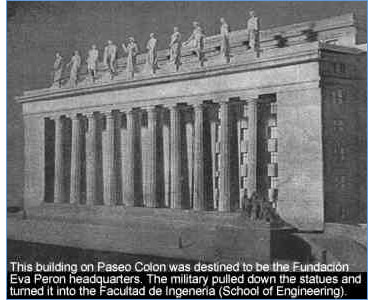 The "Student City President Perón" in the Buenos Aires
suburb of Belgrano; the Polyclinic President Perón in Avellaneda, Buenos
Aires Province; Polyclinic Evita in Lanus, Province of Buenos
Aires; Polyclinic Eva Perón in
San Martín, Buenos Aires Province; Polyclinic
August 22nd in Ezeiza, Buenos Aires Province; Children’s Polyclinic "President Perón" in the
province of Catamarca; regional polyclinics in Jujuy, Salta, Tucumán,
Catamarca, La Rioja, Mendoza, San Luis, Santiago del Estero, Santa Fe,
Corrientes and Entre Ríos; Burn Institute at Viamonte 2189, Buenos Aires;
Home School "Evita" in Ezeiza; Home School "Coronel Juan
Perón in the capital city of Jujuy; Home School "Evita" in Termas
de Reyes, Jujuy; Home School "Juan
D. Perón" in the capital city of Salta; Home School "President
Perón" in Tucumán; Home School October 17th" in Catamarca; Home
School "Coronel Perón" in La Rioja; Home Schools "Coronel
Juan Perón" and "Governor Ruperto Godoy" in San Juan; Home
School "October 17th" in Mendoza; Home School in Santa Rosa,
Eva Perón Province; Home School "August 22nd" in Mercedes, San
Luis; Home School "President Perón" in Santiago del Estero;
Home School "Coronel Perón" in Córdoba; Home School in Resistencia,
President Perón Province; Home School "Coronel Juan Perón" in
Granadero Baigorria, Santa Fe Province; Home School "President Perón"
in the capital of the province of Corrientes; Home Schools in Paraná,Entre
Ríos and Comodoro Rivadavia; International Hotel in Ezeiza, Buenos Aires
Province; Tourism hotels in Chapadmalal; Hotel Puente del Inca, Villa
Eva Perón, Mendoza; Hotels and Cottages in Embalse Río Tercero, Córdoba. The "Student City President Perón" in the Buenos Aires
suburb of Belgrano; the Polyclinic President Perón in Avellaneda, Buenos
Aires Province; Polyclinic Evita in Lanus, Province of Buenos
Aires; Polyclinic Eva Perón in
San Martín, Buenos Aires Province; Polyclinic
August 22nd in Ezeiza, Buenos Aires Province; Children’s Polyclinic "President Perón" in the
province of Catamarca; regional polyclinics in Jujuy, Salta, Tucumán,
Catamarca, La Rioja, Mendoza, San Luis, Santiago del Estero, Santa Fe,
Corrientes and Entre Ríos; Burn Institute at Viamonte 2189, Buenos Aires;
Home School "Evita" in Ezeiza; Home School "Coronel Juan
Perón in the capital city of Jujuy; Home School "Evita" in Termas
de Reyes, Jujuy; Home School "Juan
D. Perón" in the capital city of Salta; Home School "President
Perón" in Tucumán; Home School October 17th" in Catamarca; Home
School "Coronel Perón" in La Rioja; Home Schools "Coronel
Juan Perón" and "Governor Ruperto Godoy" in San Juan; Home
School "October 17th" in Mendoza; Home School in Santa Rosa,
Eva Perón Province; Home School "August 22nd" in Mercedes, San
Luis; Home School "President Perón" in Santiago del Estero;
Home School "Coronel Perón" in Córdoba; Home School in Resistencia,
President Perón Province; Home School "Coronel Juan Perón" in
Granadero Baigorria, Santa Fe Province; Home School "President Perón"
in the capital of the province of Corrientes; Home Schools in Paraná,Entre
Ríos and Comodoro Rivadavia; International Hotel in Ezeiza, Buenos Aires
Province; Tourism hotels in Chapadmalal; Hotel Puente del Inca, Villa
Eva Perón, Mendoza; Hotels and Cottages in Embalse Río Tercero, Córdoba.
Works that are under
construction and will be inaugurated soon: "University City"
in Mendoza; "University City"
in Córdoba; "University City" in Ezeiza; Children’s Polyclinic
in Warnes, Buenos Aires [this hospital for children, which would have
been the largest in Latin America, was abandoned by the military after
the 1955 Coup d’Etat and was taken over by derelicts and thieves];
Regional Polyclinics in Paraná, Entre Ríos and in Neuquén, and the Senior
Citizens Complex in Santa Fe.
This is an outline
of the Fundación Eva Perón now.
It is an enormous enterprise ... and its work to promote
social justice is far reaching.
|
 |

© Noemí Castiñeiras
Translated by Dolane Larson
(Excerpts from pages 4-11) |
From Beneficence to Social Justice
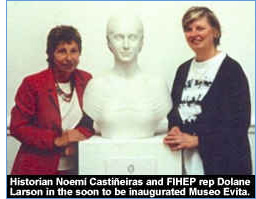 In
order to understand the social action undertaken by Evita within the framework
of Perón's first presidential term and especially with reference to the
Fundación Eva Perón, it is necessary to understand the meaning of the
revolution in social policy inserted "into the tendency of the governments
which sprang from the June 4, 1943 Revolution to modernize, restructure
and amplify the state apparatus, establishing a greater control over some
institutions and putting into practice a social policy essentially opposed
to that which had existed until that moment." (8) In
order to understand the social action undertaken by Evita within the framework
of Perón's first presidential term and especially with reference to the
Fundación Eva Perón, it is necessary to understand the meaning of the
revolution in social policy inserted "into the tendency of the governments
which sprang from the June 4, 1943 Revolution to modernize, restructure
and amplify the state apparatus, establishing a greater control over some
institutions and putting into practice a social policy essentially opposed
to that which had existed until that moment." (8)
The era of Argentine social policy which Perón
initiated from the Secretaría de Trabajo y Previsión and which later marked
his Presidency remained forever linked to Evita.
The fact that the First Lady made an incursion
into the realm of "social welfare" should not surprise anyone. All first
ladies had done so.
Men considered this a privileged way in which
women could manifest "the lovely qualities which the beautiful sex [women]
possess to a high degree" ; the institutions within this orbit were entrusted
from the beginning to the high society ladies of Buenos Aires.
The primordial objective which guided the government
at that time - "moral perfection and the cultivation of the spirit in
the beautiful sex and the dedication of that same sex to what is called
industry" (9)
The trajectory of this institution, which was
funded by donations, state subsidies (10) (*10b),
collections and social events, was not exempt from social conflicts with
its employees who received very small wages and whose right to days off
was not respected. (11)
This matter was taken under consideration just
after Peronismo came into power. On June 14, 1946, 200 employees of the
Society of Beneficence signed a petition in which they made their situation
known. A few days later, the matter was brought up in the Senate, where
Senator Diego Luis Molinari introduced a request for intervention, transmitted
to the Executive Branch on July 25.
As Marysa Navarro has stated very well, "all of these
institutions were adequate for prePeronista Argentina, but were an anachronism,
a profound contradiction to the society being gestated after Perón assumed
the presidency." (12)
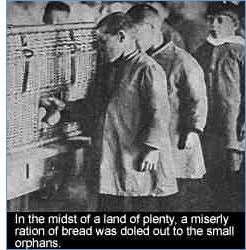 Therefore,
Degree 9414/46 declared that the Society of Beneficence of the Capital
was to be intervened "so as to restructure its organization and adjust
its function towards the technical norms and principles of assistance
and social welfare inspired by government policy" ; Dr. Armando Méndez
San Martín was designated auditor. Therefore,
Degree 9414/46 declared that the Society of Beneficence of the Capital
was to be intervened "so as to restructure its organization and adjust
its function towards the technical norms and principles of assistance
and social welfare inspired by government policy" ; Dr. Armando Méndez
San Martín was designated auditor.
The opposition connected the intervention to Eva
Perón, whom they believed to be angry because the Society ladies had rejected
her; she was seen as the deciding factor in the executive decision. Mary
Main's story,(*2b) which
has been profusely repeated and is the basis of much literature, is an
example of this version:
"It was customary for the wife of the President to become
the honorary president of the Benevolent Society.
"When Perón was inaugurated the good ladies were in
a dilemma. They could not possibly invite "that woman" to be president
of their society. It would mean establishing some sort of social contact
with her and, really, she was the sort of person who should have been
at the receiving end of charity! It was unthinkable, so they made no move.
"But Eva was not the one to allow herself to be
passed over so easily. She sent to inquire why they had not come to offer
her the presidency of their society. With their unfailing urbanity they
replied that she was, alas! too young, that their organization was one
which must be headed by a woman of maturity.
"Eva at once proposed that they should make her mother,
Doña Juana, president - a suggestion that almost makes one credit her
with a sense of humor.
.....
"This rebuff had consequences which these ladies, who had for so long
occupied an impregnable position, could not possibly have foreseen. Eva
set out to destroy both them and their Society, and out of this fury of
destruction there rose the plan for her own charitable organization...
." (13)
Argentine historian Fermín Chávez relates the
following anecdote told by Dr. Esteban Rey: "As is known, there was a
conflict which became public and which culminated with the intervention
of the Society by the Peronista government. Dr. Leloir, who was a relative
of the last president of the Society, echoed the worry the ladies had
in the sense of not having their reputations besmirched in the eyes of
posterity by what was 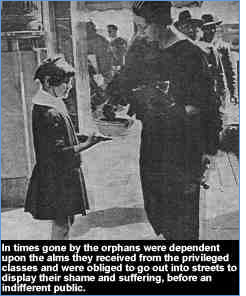 being
said about them. Therefore, he was the bearer of an invitation to Evita
(and was invited to accompany her) to visit his relative. At first the
meeting was very tense, but as tea was being served, Evita's joviality
and charm won over the ladies... . The president, after having expressed
her satisfaction at the way the meeting was going, said to her, "Señora,
we have decided that from now on we will support your work, and to start
off, we have just programmed a bridge party at the Plaza [Hotel] ... ."
She could not finish her sentence. Evita stood up and said brusquely,
"Absolutely not! You must realize that in this country the sorrows of
the poor will never again serve as entertainment for the rich. Good day,
ladies!" (14) being
said about them. Therefore, he was the bearer of an invitation to Evita
(and was invited to accompany her) to visit his relative. At first the
meeting was very tense, but as tea was being served, Evita's joviality
and charm won over the ladies... . The president, after having expressed
her satisfaction at the way the meeting was going, said to her, "Señora,
we have decided that from now on we will support your work, and to start
off, we have just programmed a bridge party at the Plaza [Hotel] ... ."
She could not finish her sentence. Evita stood up and said brusquely,
"Absolutely not! You must realize that in this country the sorrows of
the poor will never again serve as entertainment for the rich. Good day,
ladies!" (14)
To
be strictly truthful, the fate of this traditional institution had been
conceptually sealed since 1943, that is to say much before Evita could
have had any influence. Beneficence, as it was understood and practiced
until then in our country, was over; it would give way to social justice.
"...Perón has taught me," Eva would say in My
Mission in Life, "that what I do for the humble of my country is nothing
more than justice.
"...It is not philanthropy, nor is it charity,
nor is it alms, nor is it social solidarity, nor is it benevolence. It
is not even social welfare, although, to give it a more nearly appropriate
name I have called it so.
"To me it is strict justice. What made me
most indignant when I commenced it was having it classified as "alms"
or "benevolence."
"For alms, as far as I am concerned, was always
a pleasure of the rich: the soulless pleasure of exciting the desires
of the poor without ever satisfying them. And so that alms should be even
meaner and crueler, they invented "benevolence" and so added to the perverse
pleasure of giving alms the pleasure of enjoying themselves happily with
the pretext of the hunger of the poor. Alms and benevolence, to me, are
an ostentation of riches and power to humiliate the humble.
I think that God must often be ashamed of what
the poor receive in His name!" (15)
The Task
Begins
"Before
starting on the subject," Eva Peron would say in My Mission in Life,
"it is well to remember that Perón is not only President of the Republic;
he is also the Leader of his people.
"This is a fundamental condition, and is directly
related to my decision to handle the role of wife of the President of
the Republic in a manner different from any President's wife who had preceded
me.
...
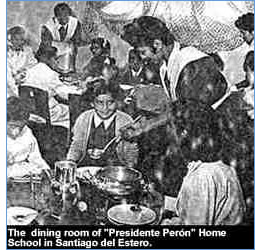 "I
had to have a double personality to correspond with Perón's double
personality. One, Eva Perón, wife of the President of the Republic,
whose work is simple and agreeable, a holiday job of receiving honors,
of gala performances; the other, "Evita," wife of the Leader
of a people who have placed all their faith in him, all their hope and
all their love." (16) "I
had to have a double personality to correspond with Perón's double
personality. One, Eva Perón, wife of the President of the Republic,
whose work is simple and agreeable, a holiday job of receiving honors,
of gala performances; the other, "Evita," wife of the Leader
of a people who have placed all their faith in him, all their hope and
all their love." (16)
With this conviction, Evita began to develop her
activity as a bridge between Perón and his people immediately after Perón's
inauguration on June 4, 1946. She interceded in favor of the workers,
visited marginalized neighborhoods, distributed clothes and food to needy
families, solved problems which people told her about in letters which
they sent to the Presidential Residence and attended to people who came
to the door.
Even though she had some idea of the difficulty
of the endeavor even before she began to undertake it, it was only after
she had begun that she realized the magnitude of her task.But by then
she had deleted from her dictionary the word "impossible." (17)
"At first I attended to everything personally.
Then I had to ask for help. Finally I was obligated to organize the work
which in just a few weeks had become extraordinary." (18)
From the beginning Evita counted on the help of
the Residence employees. Atilio Renzi, in charge of Residence personnel,
would become her right hand.
One of the garages was converted into a storehouse.
"When Eva Perón returned from a trip to the Province of Santa Fe," he
remembered, "she became enthused with the idea of creating a great social
help organization. And when the labor unions began to send her donations
(sugar from the people of Tucumán; clothes and material from the textile
unions; leather and shoes from the leather workers union), we had to find
a place to store everything: an old unused garage. The cook, Bartolo,
the waiters, Sánchez and Fernández, the maid Irma and I baptized the place
"The Delightful Store, La Tienda de las Delicias." (*3b)
After Perón had gone to bed, we would stay up
with Eva until dawn to package the merchandise. The sugar was our biggest
problem: in her enthusiasm, la Señora [Evita] spilled more on the floor
than she packaged into paper bags." (19)
In September, Evita began work in what had been
the Secretaría de Trabajo y Previsón, in the same office where Perón had
worked from 1943 to 1945, a highly symbolic act as she herself manifests
in her autobiography.
The multiplicity, diversity and urgency of the
matters brought before her caused her working day to lengthen each day
more.
.....
A little later, the until then titled "Social
Help Crusade" or "María Eva Duarte de Perón Social Work" would give way
to the "María Eva Duarte de Perón Social Work Foundation" as a consequence
of the amplitude with which Evita's activities in society had increased
and of the necessity of establishing a legally constituted organism which
could centralize and control these activities. (20)
La Fundación Eva Perón
The
María Eva Duarte Social Help Foundation was established on June 19, 1948.
Degree number 220.564 on July 8, 1948, gave it legal jurisdiction and
approved its Statutes. |
Navarro, Marysa: Evita, pg. 239
Act of Installation of the Society of Beneficence. Buenos Aires, abril
12, 1823.
Of the $17,130,839 dedicated to social welfare in the 1938 Budget, $9,989,890
went to the Society of Beneficence. In 1946, the Society received from
the National Budget the sum of $21,889,406 for salaries and administrative
expenses. |
See Diary of the Sessions of the Chamber of Deputies, 1939.
Navarro, Marysa: op.cit. pg. 242.
Main, Mary: The Woman with the Whip, pg. 102.
Chávez, Fermín: Eva Perón Sin Mitos, pgs. 189-190.
15 Perón, Eva: My Mission in Life, pg. 126.
16 Ibid, pgs. 60-61.
17 Ibid, pg. 116.
18 Ibid.
19 Borroni-Vaca: La Vida de Eva Perón. Vol. 1, pg. 226.
20 CFerioli, Néstor: La Fundación Eva Perón. Vol. 1, p.15. |
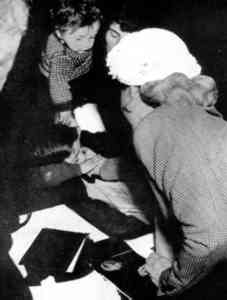 |
(*1b) Translator's note: In 1939 the Congressional Representative Juan Antonio
Solari told about Society employees who routinely worked 12 to 14 hur
days with a day off only every 10 to 15 days and were paid from 45 to
90 pesos when a fair minimum wage was considered to be 120 pesos. See
Diario de Sesiones, 1939, vol. 7.
(*2b) Translator's note: Mary Main's biography of Evita has no footnotes, no
bibliography, no documentation of any sources or references; however,
it is often cited and is the basis of the opera Evita.
(*3b) For another version of how "Las Delicias" got its name, see the Mundo
Peronista article. Click here
Bibliography
Borroni, Otelo, and
Roberto Vacca. La Vida de Eva Perón. Buenos Aires: Galerna, 1971.
Chávez, Fermín. Eva Perón Sin Mitos. Buenos Aires: Ediciones Theoría,
1996.
Ferioli, Néstor. La Fundación Eva Perón. Buenos Aires: Centro Editor
de América Latina, 1990.
Main, Mary. The Woman With the Whip. New York: Dodd, Mead & Company,
1980.
Navarro, Marysa. Evita. Buenos Aires: Planeta, 1994.
Perón, Eva. My Mission in Life. Translated by Ethel Cherry, New
York: Vantage Press, 1953.
|
|
